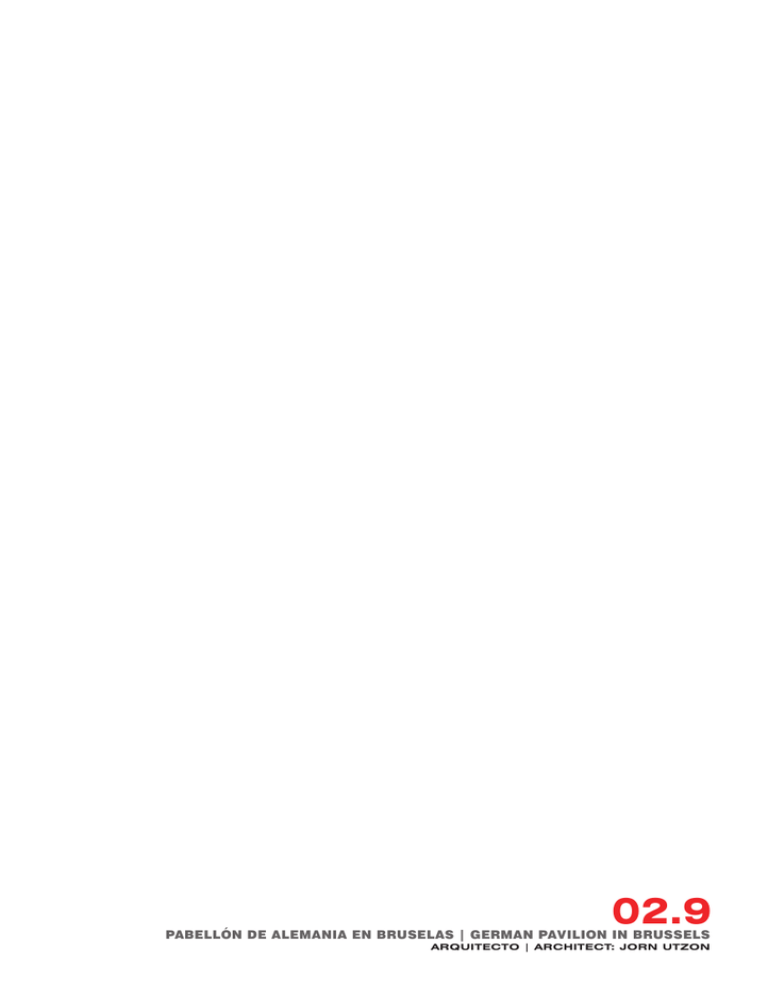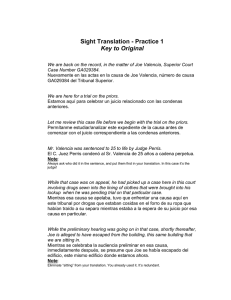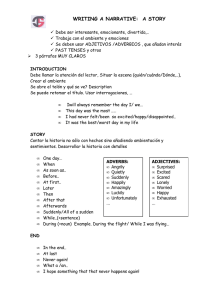PABELLÓN DE ALEMANIA EN BRUSELAS | GERMAN PAVILION IN
Anuncio

02.9 PABELLÓN DE ALEMANIA EN BRUSELAS | GERMAN PAVILION IN BRUSSELS ARQUITECTO | ARCHITECT: JORN UTZON Emplazamiento. Site. 2 PABELLÓN DE ALEMANIA EN LA EXPOSICIÓN DE BRUSELAS DEL 1958 Sep Ruf y Egon Eiermann La Exposición de Bruselas de 1958 fue una convocatoria internacional que representó la estabilización del periodo post-bélico. Los países participantes asistieron a la muestra con el optimismo inusitado propio de una sociedad que había conseguido vencer el ostracismo de una guerra que había destruido Europa, no solo desde un punto de vista físico sino también anímico. Alemania era el ejemplo más clarividente de esta superación, a pesar que todavía le perseguía la culpa moral de los crímenes de guerra re- The German Pavilion at the 1958 Brussels World Fair Sep Ruf and Egon Eiermann The 1958 Brussels Expo was an international convocation that represented the stabilization of the postwar period. The participating countries attending the fair did so with the unwonted optimism of a society that had managed to overcome the ostracism of a war which had destroyed Europe, not only from a physical but the psychic point of view. Germany was the most far-reaching example of this overcoming, notwithstanding the fact that the moral guilt of recently revealed war crimes still pursued it. Both aspects conditioned the architectonic conception of the Pavilion, presenting an architecture which, fleeing from the pomposity and monumentalism employed 3 cientemente revelados. Ambos aspectos condicionaron la concepción arquitectónica del Pabellón, presentando una arquitectura que, huyendo de la pomposidad y el monumentalismo empleados en pabellones que representaron al país en muestras internacionales durante la época del nacional socialismo (1), se amparaba en la escala humana para dar a conocer al mundo como se entendía la vida cotidiana de un país conducido por una fe ciega en el progreso. Por consiguiente, la arquitectura elegida recurrirá a la modestia, la austeridad y el rigor para desvincularse del pasado y al diálogo entre lo industrializado y lo natural para afrontar el futuro. SITUACIÓN: El área elegida para celebrar la Exposición fue un gran parque urbano estructurado a lo largo eje principal presidido por el Atomiun, construcción que se convirtió en el símbolo del evento. La parcela asignada a Alemania estaba situada en la vertiente suroeste del recinto expositivo, abarcando de una superficie de 18.000 m2 dispuesta en pendiente. Entre el límite superior, alineado al uno de los ejes primarios de la ordenación del recinto, y el inferior, coincidente con uno in pavilions that represented the country in international fairs during the era of National Socialism, [1] sought protection in the human scale in order to present to the world how the everyday life of a country driven by a blind faith in progress was understood. As a result, the chosen architecture had recourse to modesty, austerity and rigour in order to sever its connections with the past and to the dialogue between the industrialized and the natural so as to confront the future. The location: the area chosen to hold the Expo was a huge urban park structured along a main axis dominated by the Atomium, a construction that became the symbol of the event. The plot assigned to Germany was situated on the southwest side of the expo enclosure, extending over an area of 18,000 m2 of sloping land. Between the upper boundary, aligned with one of the primary axes of the enclosure layout, and the lower one, coinciding with one of the interior walkways linking the different pavilions, there was a difference of level of 6.76 m. Apart from taking this topography into consideration, the project also took the location’s pre-existing vegetation into account. Programme and planning: this depiction of life and work in postwar Germany had recourse to nine different headings: agriculture, handicrafts, industry, the city 4 de los caminos interiores que comunicaban los diferentes pabellones, existía una diferencia de cota de 6,76 mts. A parte de la consideración de esta topografía, el proyecto contempló también la vegetación preexistente del lugar. PROGRAMA Y PLANNIG: Esta representación de la vida y el trabajo en la Alemania post-bélica conllevaba abordar nueve contenidos: agricultura, artesanía, industria, ciudad y vivienda, necesidades personales, deberes y tareas sociales, salud y asistencia, ocio y educación. A parte de las áreas temáticas, el programa contemplaba también una serie de espacios complementarios como: una biblioteca, un restaurante, una vinoteca y un gran hall polifuncional previsto para dar cabida a reuniones, conciertos y conferencias. Los arquitectos plantearon el proyecto teniendo en cuenta dos consideraciones: la escala de “la casa” y el respeto a la estructura formal de su emplazamiento. IDEA FORMAL: Este punto de partida exigió de los arquitectos del edificio y del paisajista un trabajo preliminar. Sep Ruf y Egon Eierman, como arquitectos, debieron analizar con profundidad las diversas áreas del and housing, personal needs, social obligations and tasks, health and medical care, leisure and education. Apart from these thematic areas, the programme also provided for a series of complementary spaces, such as a library, a restaurant, a wine-tasting area, and a large multifunctional hall to accommodate meetings, concerts and lectures. The architects posited the design by taking two considerations into account: the scale of “the house” and respect for the formal structure of where it was. The formal idea: this point of departure called for a preliminary study on the part of the architects of the building and the landscape designer. As architects, Sep Ruf and Egon Eierman had to make a close analysis of the different areas of the programme in order to decide if the possibility existed of breaking things up so as to help attain the human scale the design was seeking. Moreover, instead of conceiving of his job of landscape design as “the introducing of the natural into the built,” Walter Rossow did things the other way round by studying the potentiality of the location in order to discover the building’s planning laws in it. The placing in common of both works gave rise to a conception totally opposed to the original idea. From the “unitary building” proposed in the preliminary de- 5 programa para deducir si existían posibilidades de disgregación que favorecieran alcanzar la escala humana que pretendía el proyecto. Por otro lado, Walter Rossow en vez de concebir su trabajo de paisajista como “la introducción de lo natural en lo construido”, actuó al revés: estudiando la potencialidad del lugar para descubrir en él las leyes de ordenación del edificio. La puesta en común de ambos trabajos dio lugar a una concepción totalmente opuesta la idea originaria. Del “edificio unitario” propuesto en el anteproyecto se pasó a un “complejo edificado” formado, no tan solo por las nueve construcciones resultantes de la descomposición del programa, sino también por la incorporación de los elementos vegetales que estructuraban el lugar. Este diálogo entre lo natural y lo construido fue viable gracias a que el zócalo utilizado como entrega entre cada uno de los módulos y la topografía existente, permitía al edificio asentarse en el terreno sin afectar al perfil de la ladera. Por otro lado, el cambio de plano que dibujaba esta base con respecto al cerramiento del pabellón alteraba la percepción del espectador, al provocarle entender sign one passed to a “built complex” formed not only by the nine constructions resulting from the splitting up of the programme but also by the incorporation of the vegetal elements that structured the location. The viability of this dialogue between the natural and the built was due to the fact that the plinth utilized as an instalment between each of the modules and the extant topography enabled the building to alight on the terrain without affecting the shape of the slope. On the other hand, the change of plane this base described in relation to the outer wall of the pavilion altered the spectator’s perception by inviting him or her to understand the complex as something which levitates, an effect that helped increase the lightness of the building system chosen. In order to preserve this idea of a “through-garden,” the connection between the different modules was realized via a walkway raised above the slope of the ground. This secondary construction fixed the altimetric position of each of the units upon requiring the alignment between the lower decks of the pavilions situated at the datum of -6.75 m and the upper decks of the pavilions located at datum 0.00 m. Not only was an “open-built complex” attained with this configuration, it also provided a flexible system by making it possible for each of the com- 6 el conjunto como algo que levita, un efecto que contribuía a aumentar la ligereza del sistema constructivo elegido. Para preservar esta idea de “jardín pasante”, la conexión entre los diferentes módulos se realizaba por una pasarela elevada de la rasante del terreno. Esta construcción secundaria fijó la posición altimétrica de cada una de las unidades, al exigir la alineación entre los forjados inferiores de los pabellones situados en la cota -6,75, con los forjados superiores de los pabellones ubicados en cota 0,00. Con esta configuración no solo se conseguía un “complejo edificado abierto”, sino que también se ofrecía un sistema flexible, al posibilitar que cada una de las piezas pudiese adoptar la proporción y la altura que cada temática requería. Por otro lado, la disposición de estas nueve piezas, unidas por pasarelas cubiertas de pérgolas, formalizaba un espacio interior que, protegido de la algarabía del recinto expositivo, perseguía rememorar una calma monástica. ESTRUCTURA PORTANTE: La limitación del plazo de tiempo para su ejecución y la exigencia de que, una vez concluida la muestra, el paponents to be able to adopt the proportion and height that each topic required. Furthermore, the layout of these nine individual elements, united by walkways covered by pergolas, formalized an interior space that, protected from the din of the expo enclosure, set out to recall a monastic calm. The loadbearing structure: the limited time for its execution and the requirement that once the fair was over the pavilion might be easily dismountable and rebuilt somewhere else obliged the architects to choose a metal framework as a loadbearing system. And so both decks and roofs were resolved with a two-way structure consisting of IPN beams placed every 3.30 m. This grid was supported by pillars, also IPN, arranged in the structural nodes located in a first ring running parallel to the line of the cornice. The spans resulting from this geometry were covered with wooden panels supported by a substructure of ten purlins, also of wood. With the aim of preserving the two-way nature of the framework, these secondary elements were placed by alternating their direction in each span. Notwithstanding its careful design, this structural checkerboard remained hidden by a plaster suspended ceiling positioned not only to facilitate the passage of installations and the fitting of recessed lights but also to achieve the isotropy each 7 bellón pudiera ser facilmente desmontable y reconstruido en otro lugar forzó a los arquitectos a elegir la estructura metálica como sistema portante. Así, forjados y cubiertas fueron resueltos con estructura bidireccional formada de vigas IPN colocadas cada 3,30 mts. Esta malla fue sustentada por pilares, también IPN, dispuestos en los nudos estructurales ubicados en primera corona paralela a la línea de cornisa. Los vanos resultantes de esta geometría se cubrieron con paneles de madera soportados por una subestructura de 10 correas también de madera. Con el objeto de conservar la bidireccionalidad de la estructura, estos elementos secundarios se colocaron alternando su dirección en cada vano. A pesar del su cuidado diseño, este damero estructural quedó oculto por un cielo raso de yeso colocado no sólo para posibilitar el paso de instalaciones y la colocación de luminarias empotradas, sino también para conseguir la isotropía que requiere cualquier espacio expositivo. SISTEMA DE CERRAMIENTO: El espacio comprendido entre estas dos plataformas horizontales fue acotado por dos planos verticales sepaexhibition space required. The walling system: the space contained between these two horizontal platforms was bounded by two vertical planes 1.30 m apart: one that served to delimit the built space and the other to close it off. The physical boundary consisted of fixed vertical elements which, evolving between the edges of the deck, structured the rhythm of a number of moveable components: aluminium louvers which, housed behind the upper cornice, resolved the sun and light control of the interior space. The interior plane, where the walling was located, was structured with cross-shaped vertical elements conceived as supports for the sheets of glass that described the inner perimeter of the exhibition space. Both the elements used to define the boundary and those that structured the walling were modulated according to the order dictated by the two-way structure: 3.30 m. Elena Fernández 8 rados entre ellos 1,30 mts: uno que servía para delimitar el espacio construido y el otro para cerrarlo. El límite físico estaba compuesto por unos elementos verticales fijos, que desarrollados entre los cantos del forjado, estructuraban el ritmo de unos elementos móviles: unas persianas de lamas de aluminio que, recogidas detrás de la cornisa superior, resolvían el control solar y lumínico del espacio interior. El plano interior, donde se ubicaba el cerramiento, se estructuró con unos elementos verticales de planta cruciforme pensados como soportes de los planos de vidrio que dibujaban el perímetro interior del espacio expositivo. Tanto los elementos usados para definir el límite, como aquellos que estructuraban el cerramiento se modularon siguiendo el orden dictado por la estructura bidireccional: 3,30 mts. Elena Fernández Entrada. Entrance. 9 Planta. Cota +0.0 Plan. Level +0.0 Planta. Cota +3.63 Plan. Level +3.63 10 Planta. Cota -3.63 Plan. Level -3.63 Planta. Cota -6.76 Plan. Level -6.76 11 Sección. Section. Detalle. Detail. 12 Acceso superior. Upper access. 13 Exterior. Exterior. 14 Exterior. Exterior. 15 Pasarela. Footbridge. Pasarela. Footbridge. 16 Espacio expositivo. Exhibition space. 17 GRUPO pab . PROYECTOS VII-VIII. DEPARTAMENTO DE PROYECTOS ARQUITECTÓNICOS DE BARCELONA. ETSAB/upc. Diagonal 649, 5ª planta. Despacho 5.4




